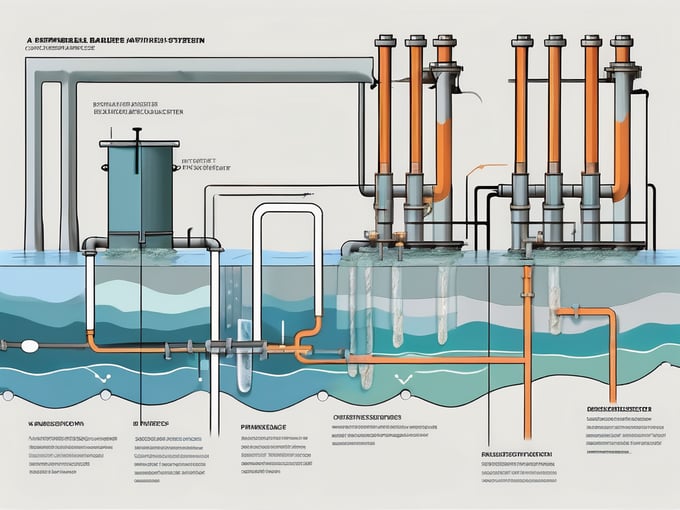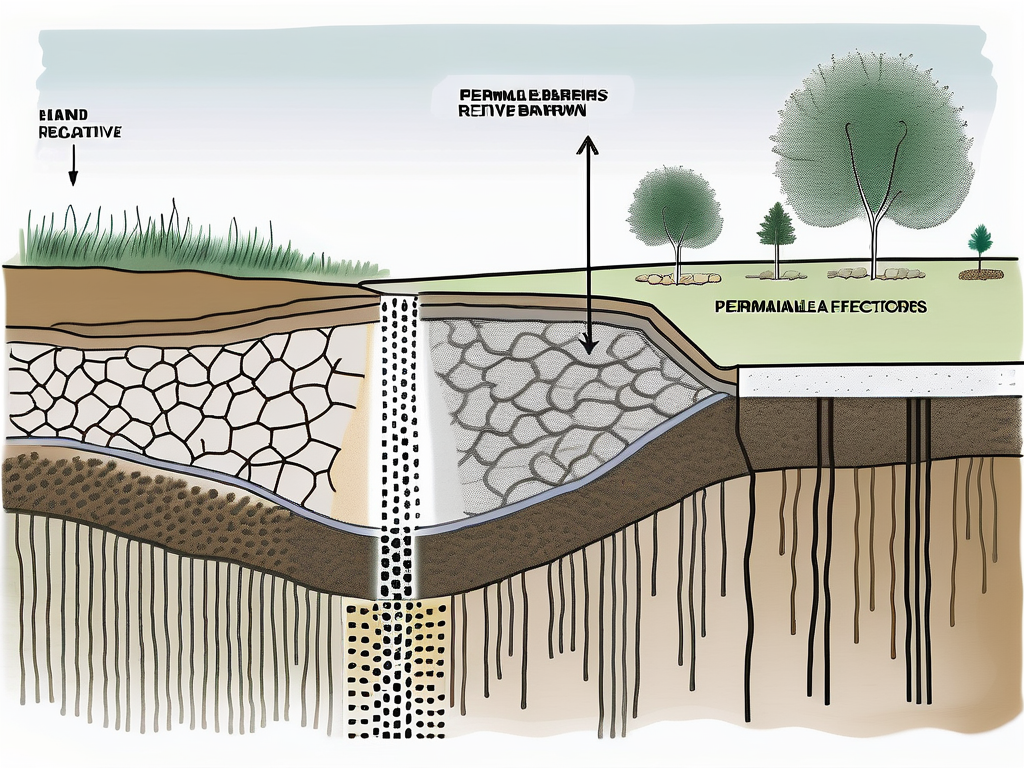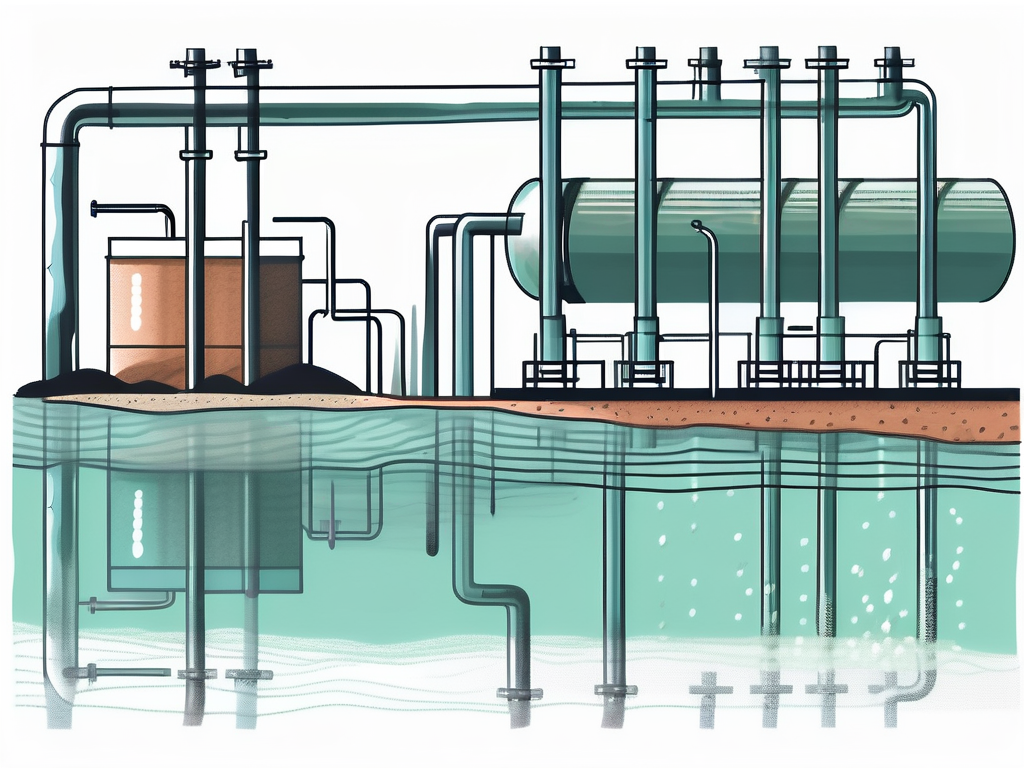
Permeable Reactive Barrier: Wastewater Treatment Explained
In the realm of wastewater treatment, the term 'Permeable Reactive Barrier' (PRB) refers to a technology that is designed to treat contaminated groundwater. This technology utilizes a reactive material to remove or degrade pollutants as groundwater flows through it. The PRB acts as an underground wall that intercepts the flow of contaminated groundwater, treating the water as it passes through the barrier.
The concept of PRB was first introduced in the late 1980s and has since been widely adopted for the treatment of various types of contaminants. The technology has been proven to be effective, cost-efficient, and environmentally friendly, making it a popular choice for wastewater treatment. This article will delve into the intricate details of PRB, its working mechanism, types, applications, advantages, and limitations.
Working Mechanism of Permeable Reactive Barrier
The working mechanism of a PRB is based on the principle of contaminant removal or degradation as the contaminated groundwater flows through the barrier. The barrier is filled with a reactive material that is capable of treating the specific contaminants present in the groundwater. The treatment process may involve various chemical, biological, or physical reactions, depending on the type of contaminants and the reactive material used.
As the contaminated groundwater flows into the PRB, it comes into contact with the reactive material. The contaminants in the water react with the material, leading to their removal or degradation. The treated water then continues to flow out of the barrier, leaving the contaminants behind. The barrier is designed such that it does not impede the natural flow of groundwater, ensuring that all the contaminated water passing through the area is treated.
Chemical Reactions
Chemical reactions play a crucial role in the working of a PRB. The reactive material used in the barrier is chosen based on its ability to chemically react with the contaminants present in the groundwater. The reactions may involve processes such as precipitation, adsorption, redox reactions, or complexation. These reactions result in the transformation of the contaminants into less harmful or non-harmful substances.
For instance, in the case of heavy metal contamination, the reactive material may be chosen for its ability to precipitate the metals out of the water. The metals react with the material, forming insoluble compounds that are trapped within the barrier. Similarly, for organic contaminants, the reactive material may be chosen for its ability to promote redox reactions, leading to the degradation of the contaminants.
Biological Reactions
Biological reactions are another important aspect of the working of a PRB. In some cases, the reactive material used in the barrier may contain microorganisms that are capable of degrading the contaminants. This is particularly useful for the treatment of organic contaminants, which can often be broken down by specific types of bacteria or fungi.
The microorganisms in the barrier metabolize the contaminants as they pass through, transforming them into less harmful substances. This process, known as bioremediation, is a natural and environmentally friendly method of wastewater treatment. It is worth noting that the effectiveness of bioremediation depends on various factors, including the type of contaminants, the species of microorganisms, and the environmental conditions within the barrier.
Types of Permeable Reactive Barriers
There are several types of PRBs, each designed to treat specific types of contaminants. The type of PRB used in a particular situation depends on the nature of the contamination, the characteristics of the groundwater, and the site conditions. The following sections will discuss the most common types of PRBs and their applications.
The two main types of PRBs are in-situ PRBs and ex-situ PRBs. In-situ PRBs are installed directly in the path of the contaminated groundwater, while ex-situ PRBs involve the extraction of groundwater, which is then treated above ground before being returned to the aquifer. Each of these types has its own advantages and limitations, which will be discussed in the following sections.
In-Situ Permeable Reactive Barriers
In-situ PRBs are the most commonly used type of PRB. They are installed directly in the path of the contaminated groundwater, allowing the water to flow naturally through the barrier. The reactive material in the barrier treats the contaminants as the water passes through. In-situ PRBs are typically used for the treatment of plumes of contaminated groundwater, where the direction of groundwater flow is well known.
The main advantage of in-situ PRBs is that they do not require the extraction of groundwater, making them less disruptive and more cost-effective than other treatment methods. However, they do require careful design and installation to ensure that they intercept all the contaminated groundwater. They also require regular monitoring to ensure that they continue to function effectively over time.
Ex-Situ Permeable Reactive Barriers
Ex-situ PRBs involve the extraction of groundwater, which is then treated above ground before being returned to the aquifer. The groundwater is pumped out of the ground, passed through a treatment system containing the reactive material, and then returned to the ground. This allows for more control over the treatment process, as the conditions can be adjusted to optimize the performance of the reactive material.
While ex-situ PRBs offer more control over the treatment process, they are typically more expensive and disruptive than in-situ PRBs. They require the installation of a pumping system and a treatment system, and they may also require the treatment of the extracted water to meet discharge standards. However, they can be an effective solution in situations where in-situ PRBs are not feasible or effective.
Applications of Permeable Reactive Barriers
PRBs have a wide range of applications in the field of wastewater treatment. They can be used to treat various types of contaminants, including heavy metals, organic compounds, radionuclides, and more. The following sections will discuss some of the most common applications of PRBs.
One of the main applications of PRBs is in the treatment of groundwater contaminated with heavy metals. Heavy metals are a common type of groundwater contaminant, resulting from various industrial activities. PRBs can effectively remove heavy metals from groundwater through processes such as precipitation and adsorption.
Treatment of Organic Contaminants
PRBs are also commonly used for the treatment of organic contaminants in groundwater. Organic contaminants can come from a variety of sources, including industrial waste, agricultural runoff, and more. These contaminants can be harmful to both human health and the environment, making their removal a priority.
The reactive material used in the PRB can promote various chemical and biological reactions that degrade the organic contaminants. For instance, zero-valent iron (ZVI) is a common reactive material used for the treatment of chlorinated solvents, a common type of organic contaminant. The ZVI promotes reductive dechlorination, a chemical reaction that breaks down the chlorinated solvents into less harmful substances.
Treatment of Radionuclides
Another important application of PRBs is in the treatment of radionuclides in groundwater. Radionuclides are radioactive substances that can be harmful to human health and the environment. They can enter the groundwater through various sources, including nuclear power plants, medical facilities, and more.
PRBs can effectively remove radionuclides from groundwater through processes such as adsorption and precipitation. The reactive material used in the PRB can bind with the radionuclides, trapping them within the barrier. This prevents the radionuclides from spreading further into the groundwater, protecting both human health and the environment.
Advantages of Permeable Reactive Barriers
PRBs offer several advantages over other methods of wastewater treatment. One of the main advantages is their cost-effectiveness. PRBs are typically less expensive to install and operate than other treatment methods, making them a cost-effective solution for the treatment of contaminated groundwater.
Another major advantage of PRBs is their environmental friendliness. PRBs do not require the use of harmful chemicals or energy-intensive processes, making them a sustainable option for wastewater treatment. Furthermore, the treatment process takes place underground, minimizing the impact on the surface environment.
Long-Term Effectiveness
PRBs are designed to provide long-term treatment of contaminated groundwater. Once installed, a PRB can continue to treat contaminated groundwater for many years, with minimal maintenance required. This makes PRBs a sustainable and long-term solution for the treatment of contaminated groundwater.
The long-term effectiveness of a PRB depends on several factors, including the type of contaminants, the reactive material used, and the site conditions. Regular monitoring is required to ensure that the PRB continues to function effectively over time. However, with proper design and maintenance, a PRB can provide effective treatment for many years.
Minimal Disruption
Another advantage of PRBs is that they cause minimal disruption to the environment and the local community. The installation of a PRB does not require the excavation of large areas of land, and the treatment process takes place underground, out of sight. This makes PRBs a suitable option for sites where other treatment methods would be too disruptive.
Furthermore, PRBs do not produce any noise or odors, making them a good choice for sites located near residential areas. The only visible sign of a PRB is the monitoring wells used to check the performance of the barrier, which can be easily integrated into the landscape.
Limitations of Permeable Reactive Barriers
While PRBs offer many advantages, they also have some limitations. One of the main limitations is that they are not suitable for all types of contaminants. The effectiveness of a PRB depends on the type of contaminants and the reactive material used. Some contaminants may not react with the material, or the reactions may not be sufficient to fully remove or degrade the contaminants.

Another limitation of PRBs is that they require a thorough understanding of the site conditions and the groundwater flow. The design and installation of a PRB must take into account the direction and speed of groundwater flow, the depth of the groundwater, the geology of the site, and more. If these factors are not properly considered, the PRB may not intercept all the contaminated groundwater, or it may not function effectively.
Long-Term Performance
While PRBs are designed for long-term treatment, their performance can decrease over time. The reactive material in the barrier can become depleted or less effective, reducing the treatment capacity of the PRB. Furthermore, the barrier can become clogged with precipitates or biofilms, impeding the flow of groundwater through the barrier.
Regular monitoring and maintenance are required to ensure the long-term performance of a PRB. In some cases, the reactive material may need to be replaced, or the barrier may need to be cleaned or repaired. Despite these challenges, with proper management, a PRB can provide effective treatment for many years.
Regulatory Challenges
Another limitation of PRBs is the regulatory challenges associated with their use. The installation of a PRB involves the placement of a reactive material in the ground, which can be subject to environmental regulations. Furthermore, the treated water must meet certain quality standards before it can be discharged back into the environment.
Compliance with these regulations can add to the cost and complexity of using a PRB. However, with careful planning and management, these challenges can be overcome. It is important to work with regulatory agencies from the early stages of a PRB project to ensure compliance with all relevant regulations.
Conclusion
In conclusion, Permeable Reactive Barriers are a powerful tool in the field of wastewater treatment. They offer a cost-effective, environmentally friendly, and long-term solution for the treatment of contaminated groundwater. With a thorough understanding of the technology and careful planning, PRBs can be successfully used to treat a wide range of contaminants.

Despite their limitations, the benefits of PRBs far outweigh their drawbacks. They represent a promising technology for the sustainable treatment of wastewater, contributing to the protection of our precious water resources. As research and development continue in this field, we can expect to see further improvements in the effectiveness and versatility of PRBs.



